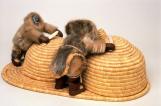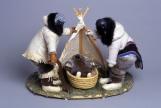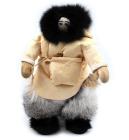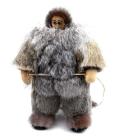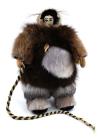2
Elisapie Inukpuk [b. 1938]"One doll I gave to a school was a woman dressed in a caribou amauti and walking with a dog who was carrying a pack. That's the one I like the best."
"I now make the heads and the bases myself. In the past I thought I could not make heads, so my husband Charlie used to make them. When he stopped carving, I started making them on my own. Still, when I am in a rush, he occasionally makes a head for me."
"My philosophy of life is the importance of treating each other with respect. Do not use things leading to a destructive lifestyle. The gift of life is given to us. Our grandparents lived their lives respectfully. Life is precious and if there had not been a destructive force on the earth, people who otherwise would be good people would not have messed up their lives. They don't do this on purpose, but because they are deceived. There is potential in life. Our ancestors lived without dangers such as there are today. Although that time cannot be brought back, we think of our elders."
Her story
Elisapie Inukpuk was born in 1938, in Sarollie's Camp, near Inukjuak. Eventually, her family moved to Kangirsukallak. One of seven children, she did not attend school, but stayed home to help her mother after her father's death in 1945. She was influenced to make dolls by her mother, who made her a complete family of dolls, sewn out of cloth and string, for her to play with when she was young. "I started [dollmaking] when I was a little girl. I made one small doll a long time ago, when the only store was the Hudson's Bay Company. The co-op store did not exist then. I made one small doll, using a white stone from the seashore to make the head. It brought $4 - four big dollars. I was surprised! At that time, the items at the store cost very little. I was able to fill the top of my box with bottles of perfume. My brother Shaumik used to be very good to me. He took my sewing to the store all the time. I used to make slippers, and when I made that doll, it brought $4 for which I got lots of perfume. I was so happy that I kept on making dolls. That was my first accomplishment in sewing," she said during an interview with her niece, Martha Inukpuk-Iqaluk, in 1974 (The Interview was published in Inuit Art Quarterly [IAQ] in 1996).
She first gained attention after winning two doll-making prizes at the Crafts from Arctic Canada competition in Toronto in 1974. Since then, she has progressed from making dolls entirely out of cloth to incorporating and carving stone for the heads and bases, and grass for the bases. Mainly, she sells her work to the Inukjuak co-op, although the Inuit doll market in Canada is virtually non-existent. At one point, she was forced to stop sewing because of pain in both her hands. "They were both operated on and now I can sew without any problem. The situation was brought on by sewing all the time. I am happy because I can sew again; I look at my hands and thank them." Elisapie has travelled to other communities in Nunavik to teach dollmaking.
Her art
Elisapie Inukpuk's dolls, or "small sculptures" as she likes to call them, are made from a variety of materials, including skins, fur, cloth, grass and beads. "The small mittens and the kamiks are very hard work, so I work on them first and do the body later." Her husband, Charlie, used to carve the heads of her dolls, but she now mostly does that herself, as well as making the bases, usually out of woven grass. "In the spring, I make the grass bases on which the dolls stand. That is the time when the grass is good and I prepare it before receiving any orders. I do more grass weaving in the spring and make the dolls in the fall. I put heavy items on the finished grass base because it is flexible and tends to get lopsided when left alone. It has to be stored safely." Other materials for her dolls are often given to her by members of the community. "They keep me in mind and bring me remnants from their own sewing. When I can get tanned caribou skin, I use it to make dolls. Tanned caribou skins are my favourite." When working with caribou skin, she removes the fur and tans the skins herself. She made dolls out of sealskin, until Greenpeace mounted its highly publicized campaign against the killing of seals. She stuffs the dolls with felt and she inserts a small piece of wood inside them if she wants them to stand up straight (her dolls are often between 15 and 18 inches high). She also incorporates beads on the clothing, an element she finds particularly challenging due to the small size of the beads. "Dollmaking is very time consuming. After the clothes are finished, I put them on the doll and it literally becomes a person. That's the part I like best." When she is finished she takes photographs of them.
Many of her dolls have stories. "When my dolls were in demand, I used to make Kautajajautjuk [an orphan boy in a story who was treated badly by the people in a particular camp, but who retaliated when he grew up]. I also made dolls of the old woman who used her cane to kill a polar bear by stuffing her mitten in its mouth." Others imitate work activities, such as dolls of men holding an avataq [sealskin float], drying skins, and stretching kamiks.
References
Most of the information above is taken from a 1974 interview by Elisapee Inukpuk's niece, Martha Inukpuk-Iqaluk. It was published in a 1996 issue of Inuit Art Quarterly (IAQ), "I enjoy dollmaking immensely," vol. 11, no. 4 (winter):10-13.


